Perang Dunia I (juga dinamakan Perang Dunia Pertama, dan nama dalam
bahasa Inggris lainnya: Great War, War of the Nations, dan “War to End
All Wars” (Perang untuk Mengakhiri Semua Perang) adalah sebuah konflik
dunia yang berlangsung dari tahun 1914 hingga tahun 1918. Perang ini
dimulai setelah Pangeran Ferdinand dari Austria dibunuh anggota kelompok
teroris Serbia, Gavrilo Principe di daerah Sarajevo
Tidak pernah terjadi sebelumnya konflik sebesar ini, baik dari jumlah
tentara yang dikerahkan dan dilibatkan, maupun jumlah korbannya.
Senjata kimia digunakan untuk pertama kalinya, pemboman massal warga
sipil dari udara dilakukan, dan banyak dari pembunuhan massal berskala
besar pertama abad ini berlangsung saat perang ini. Empat dinasti,
Habsburg, Romanov, Ottoman dan Hohenzollern, yang mempunyai akar
kekuasaan hingga zaman Perang Salib, seluruhnya jatuh setelah perang.
Perang Dunia I menandai berakhirnya monarki absolutisme di Eropa. Ia
juga menjadi pemicu Revolusi Rusia, yang akan menginspirasi revolusi
lainnya di negara lainnya seperti Tiongkok dan Kuba, dan akan menjadi
basis bagi Perang Dingin antara Uni Soviet dan AS. Kekalahan Jerman
dalam perang ini dan kegagalan untuk menyelesaikan masalah-masalah yang
masih menggantung yang telah menjadi sebab terjadinya Perang Dunia I
akan menjadi dasar kebangkitan Nazi, dan menjadi sebab pecahnya Perang
Dunia II pada 1939. Ia juga menjadi dasar bagi peperangan bentuk baru
yang sangat bergantung kepada teknologi, dan akan melibatkan non-militer
dalam perang seperti yang belum pernah terjadi sebelumnya.
LATAR BELAKANG
1. Pembunuhan Pangeran Austria Franz Ferdinand oleh kelompok teroris
Serbia, Gavrilo Principe di Sarajevo, Bosnia. Principe menganggap bahwa
latihan perang tentara Austria di Bosnia adalah pelecehan terhadap
Serbia. Bosnia sendiri adalah negara sengketa antara Austria dan Serbia.
Kemudian Austria memberi ultimatum Serbia jika Principe tidak
diserahkan (ke Austria) dalam waktu satu bulan, maka Austria akan
menyerang Serbia
Serbia yang melindungi warga negaranya, tidak mau menyerahkan
Principe. Serbia berani menentang Austria karena Rusia berjanji akan
membantu Serbia jika Serbia diserang Austria.
Maka pada tanggal 28 Juli 1914 Austria menyerang Serbia.
2. Persaingan merebut daerah sumber bahan baku, penanaman modal, dan daerah pemasaran.
3. Munculnya persekutuan / Blok persaingan politik antar negara-negara
Eropa : Triple Alliance : Jerman, Austria, Italia, Triple Entente :
Inggris, Perancis, Uni Soviet
Di Eropa abad ke-19, penjajahan tersebar luas. Kekuatan bangsa Eropa
seperti Inggris dan Prancis telah membangun kekuasaan penjajahan di
keempat penjuru dunia. Jerman, yang telah membangun kesatuan politiknya
lebih lama daripada negara-negara lain, bekerja keras untuk menjadi
pelopor dalam perlombaan ini.
Pada awal abad ke-20, hubungan yang didasarkan pada kepentingan telah
membagi Eropa menjadi dua kutub yang berlawanan. Inggris, Prancis, dan
Rusia berada di satu pihak, dan Jerman beserta Kekaisaran
Austria-Hungaria yang diperintah oleh keluarga Hapsburg asal Jerman
berada di pihak lainnya.
Ketegangan antara kedua kelompok ini semakin hari semakin meningkat,
hingga akhirnya suatu pembunuhan pada tahun 1914 menjadi pemicu perang.
Pangeran Franz Ferdinand, pewaris tahta Kekaisaran Austria-Hungaria,
dibunuh oleh kaum nasionalis Serbia yang berusaha menekan pengaruh
kekaisaran tersebut di daerah Balkan.
Dalam kurun waktu yang amat singkat, hasutan setelah peristiwa ini
menyeret seluruh benua Eropa ke dalam kancah peperangan. Pertama,
Austria-Hungaria menyatakan perang kepada Serbia. Rusia, sekutu abadi
bangsa Serbia kemudian menyatakan perang terhadap Austria-Hungaria.
Lalu satu demi satu, Jerman, Inggris, dan Prancis, memasuki peperangan. Sumbu sudah dinyalakan.
Bahkan sebelum perang dimulai, Dewan Jenderal Jerman telah membuat
rencana dan memutuskan untuk menguasai Prancis melalui serangan
mendadak. Untuk mencapai tujuan ini, orang-orang Jerman memasuki Belgia
dan kemudian melintasi perbatasan memasuki Prancis. Menanggapi dengan
cepat, pasukan Prancis menghentikan pasukan Jerman di tepi Sungai Marne
dan memulai suatu serangan balik.
SITUASI PERANG DI PARIT PERLINDUNGAN
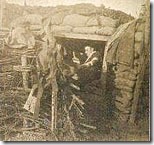
Perang Dunia menjadi terkenal dengan peperangan parit perindungannya,
di mana sejumlah besar tentara dibatasi geraknya di parit-parit
perlindungan dan hanya bisa bergerak sedikit karena pertahanan yang
ketat. Ini terjadi khususnya terhadap Front Barat. Lebih dari 9 juta
jiwa meninggal di medan perang, dan hampir sebanyak itu juga jumlah
warga sipil yang meninggal akibat kekurangan makanan, kelaparan,
pembunuhan massal, dan terlibat secara tak sengaja dalam suatu
pertempuran, terjebak diantara peperangan.
Perang parit menjadi strategi utama Perang Dunia Pertama. Selama
beberapa tahun berikutnya, bisa dikatakan, para serdadu hidup dalam
parit-parit ini. Kehidupan di sana benar-benar sulit. Para prajurit
hidup dalam ancaman terus-menerus dibom, dan mereka tak henti-hentinya
menghadapi ketakutan dan ketegangan yang luar biasa. Mayat mereka yang
telah tewas terpaksa dibiarkan di tempat-tempat ini, dan para serdadu
harus tidur di samping mayat-mayat tersebut. Bila turun hujan,
parit-parit itupun dibanjiri lumpur yang membatasi gerak mereka.
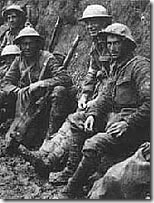
Lebih dari 20 juta serdadu yang bertempur di Perang Dunia I mengalami
keadaan yang mengerikan di dalam parit-parit ini, dan sebagian besar
meninggal di sana. Dalam beberapa minggu setelah dimulai oleh serangan
Jerman pada tahun 1914, garis barat perang ini sebenarnya terpaku di
jalan buntu. Para serdadu yang bersembunyi di parit-parit ini terjebak
dalam jarak yang hanya beberapa ratus meter jauhnya satu sama lain.
Setiap serangan yang dilancarkan sebagai upaya mengakhiri kebuntuan ini
malah menelan korban jiwa yang lebih banyak.
STRATEGI JERMAN
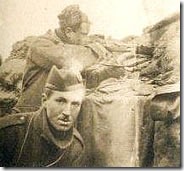
Di awal tahun 1916, Jerman mengembangkan rencana baru untuk mendobrak
garis barat. Rencana mereka adalah secara mendadak menyerang kota
Verdun, yang dianggap sebagai kebanggaan orang Prancis. Tujuan
penyerangan ini bukanlah memenangkan perang, melainkan menimbulkan
kerugian yang besar di pihak tentara Prancis sehingga melemahkan
perlawanan mereka. Kepala staf Jerman Falkenhayn memperkirakan bahwa
setiap satu serdadu Jerman saja dapat membunuh tiga orang serdadu
Prancis.
Serangan dimulai pada tanggal 21 Febuari. Para pemimpin Jerman
memerintahkan serdadunya untuk “keluar dari parit mereka,” namun tiap
serdadu yang melakukannya justru telah tewas atau sekarat dalam sekitar
tiga menit. Meskipun penyerangan berlangsung tanpa henti selama
berbulan-bulan, Jerman gagal menduduki Verdun.
Secara keseluruhan, kedua pihak kehilangan sekitar satu juta serdadu.
Dan dengan pengorbanan itu, garis depan hanya berhasil maju sekitar 12
kilometer. Satu juta orang mati demi selusin kilometer.
BALASAN INGGRIS
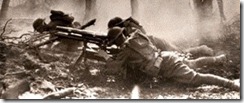
Inggris membalas serangan Jerman di Verdun dengan Pertempuran Somme.
Pabrik-pabrik di Inggris membuat ratusan ribu selongsong meriam.
Rencana Jendral Douglas Haig mendorong Pasukan Inggris untuk
menghujani dengan pengeboman terus-menerus selama seminggu penuh, yang
diikuti dengan serangan infanteri. Dia yakin mereka akan maju sejauh 14
kilometer di hari pertama saja dan kemudian menghancurkan semua garis
pertahanan Jerman dalam satu minggu.
Serangan dimulai pada tanggal 1 Juni. Pasukan meriam Inggris
menggempur pertahanan Jerman selama seminggu tanpa henti. Di akhir
minggu tersebut, para perwira Inggris memerintahkan serdadunya memanjat
keluar dari parit. Namun, selama pengeboman tersebut para serdadu Jerman
berlindung dengan rapat di kedalaman parit persembunyian mereka
sehingga tidak terlumpuhkan dan menggagalkan rencana Inggris. Begitu
serdadu Inggris bergerak melintasi garis depan, serdadu Jerman muncul
menyerang mereka dengan senapan mesinnya. Sejumlah total 20.000 serdadu
Inggris tewas dalam beberapa jam pertama perang tersebut. Di dalam
kegelapan malam itu, daerah di antara dua garis pertempuran penuh dengan
puluhan ribu mayat dan juga serdadu yang terluka, yang mencoba
merangkak mundur.
Pertempuran Somme tidak berlangsung dua minggu seperti yang
direncanakan Jendral Haig, melainkan lima bulan. Bulan-bulan ini tidak
lebih daripada pembantaian. Para jendral bertubi-tubi mengirimkan
gelombang demi gelombang serdadu mereka menuju kematian yang telah
pasti. Di akhir pertempuran, kedua belah pihak secara keseluruhan telah
kehilangan 900.000 prajuritnya. Dan untuk ini, garis depan bergeser
hanya 11 kilometer. Para serdadu ini dikorbankan demi 11 kilometer saja.
JUMLAH KORBAN
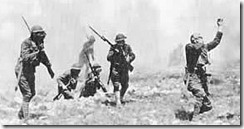
* Belgia: 13.700
* Kekaisaran Britania: 908.000
o Australia: 60.000
o Kanada: 55.000
o India: 25.000
o Selandia Baru: 16.000
o Afrika Selatan: 7.000
o Inggris: 715.000
* Perancis: 1.354.000
* Yunani: 5.000
* Italia: 650.000
* Jepang: 300
* Rumania: 336.000
* Rusia: 1.700.000
* Serbia: 450.000
* AS: 50.600
Kekuatan As ( Axis Powers ): 3.382.500
* Austria-Hungaria: 1.200.000
* Bulgaria: 87.500
* Jerman: 1.770.000
* Kerajaan Ottoman: 325.000
Warga sipil: 6.493.000
* Austria: 300.000
* Belgia: 30.000
* Inggris: 31.000
* Bulgaria: 275.000
* Perancis: 40.000
* Jerman: 760.000
* Yunani: 132.000
* Rumania: 275.000
* Rusia: 3.000.000
* Serbia: 650.000
* Kerajaan Ottoman: 1.000.000
Kedua belah pihak melakukan lebih banyak serangan lagi selama Perang
Dunia I, dan setiap serangan ini menjadi pembantaian diri sendiri. Di
kota Ipres di Belgia saja, berlangsung tiga pertempuran. Setengah juta
serdadu tewas di pertempuran ketiga saja. Setiap serangan berakibat
sama: Ribuan nyawa melayang hanya untuk maju beberapa kilometer.
Peperangan yang mengerikan ini, yang tidak punya alasan kuat, menelan
nyawa orang tak bersalah yang tak terhitung banyaknya. Banyak orang
kehilangan saudaranya atau harus meninggalkan rumahnya.
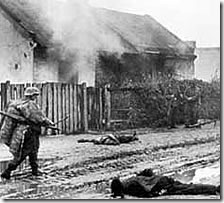

AKHIR PEPERANGAN
Kekalahan Jerman di Front Barat mengakibatkan kehidupan rakyat
semakin bertambah susah. Keadaan Jerman seperti ini menimbulkan gerakan
dari kaum komunis (spartacis) yang hendak menggulingkan pemerintahan.
Jerman menghadapi serangan dua kali yaitu dari pihak sekutu dan
pemberontakan dari kaum komunis. Karena serangan itu Jerman terpaksa
menyerah pada tahun 1918. Hitler menamakan gerakan spartacis itu sebagai
tusukan pisau dari belakang punggung Jerman, yang menyebabkan Kaisar
Wilhelm II turun takhta dan pemerintahan dipegang oleh Elbert (beraliran
sosialis). Akhirnya, Jerman dijadikan republik dan selanjutnya menyerah
kepada pihak sekutu.
Sementara itu di Austria timbul pemberontakan-pemberontakan yang
dilakukan oleh kaum komunis dan kaum Slavia, yang mengakibatkan Kaisar
Karl (pengganti Kaisar Frans Joseph II) terpaksa turun takhta tahun 1918
sehingga Austria-Hongaria menjadi republik.
Setelah Perang Dunia I berakhir, baik negara-negara yang menang perang
maupun yang kalah perang sibuk mengadakan perjanjian-perjanjian damai
seperti : Perjanjian Versailles, Perjanjian St.Germain, Perjanjian
Neuilly, Perjanjian Trianon, dan Perjanjian Sevres.
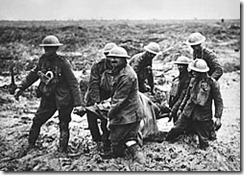
Pada tahun 1918, Perang Dunia I akhirnya berakhir, setelah empat
tahun serangan tanpa guna di tangan tentara Jerman, Prancis, dan
Inggris. Namun perdamaian ini, yang dinyatakan pada jam 11 pagi, hari
kesebelas dari bulan kesebelas, tidak membawa kebahagiaan untuk siapa
pun. Ratusan ribu serdadu menjadi cacat. Sebagian lainnya terbukti tidak
mampu mengatasi dampak kejiwaan karena perang setelah tinggal di dalam
parit yang penuh dengan lumpur, kotoran, dan mayat. Bentuk trauma yang
dikenal sebagai “shell shock” atau “kejutan bom” sangat umum di antara
para veteran perang, dan hal ini menyebabkan penderitanya mengalami
serangan ketakutan dan goncangan yang berat. Rasa takut akan dibom, yang
mereka alami setiap hari selama empat tahun berturut-turut, telah
terukir di benak mereka. Ada beberapa penderita yang merasa harus segera
bersembunyi hanya karena kata ‘bom’ disebutkan. Beberapa veteran bahkan
merasa ngeri setiap kali mereka melihat seragam. Puluhan ribu serdadu
juga kehilangan satu atau lebih anggota badannya dalam perang ini.
Serdadu ini adalah tentara yang mata, dagu, atau hidungnya menjadi cacat
selama pengeboman, sehingga topeng khusus diciptakan di Eropa untuk
menyembunyikan wajah mereka yang cacat.
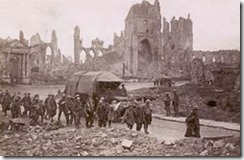
Sumber: website dibalik perang dunia, wikipedia
English Version
World
War I (also known as the First World War, and in other English names:
Great War, the War of the Nations, and the "War to End All Wars" (War to
End All Wars) was a world conflict that lasted from 1914 to in
1918. war started after Prince Ferdinand of Austria assassinated
Serbian terrorist group members, Gavrilo Principe Sarajevo area
Never happened before this big conflict, both from the number of troops deployed and engaged, as well as the number of victims. Chemical
weapons used for the first time, the mass bombing of civilians from the
air to do, and many of the first large-scale massacres of the century
took place when this war. Four
dynasty, Habsburg, Romanov, Hohenzollern and Ottoman, having roots
power until the time of the Crusades, all fell after the war.
World War I marked the end of monarchical absolutism in Europe. It
also triggers the Russian Revolution, which would inspire other
revolutions in other countries such as China and Cuba, and would become
the basis of the Cold War between the Soviet Union and the United
States. The
defeat of Germany in this war and the failure to resolve the issues
that are still hanging that has a cause of World War I would be the
basis of the rise of the Nazis, and the cause of the outbreak of World
War II in 1939. He
also became the basis for a new form of warfare that relies heavily on
technology, and will involve non-military in a war like never before.
BACKGROUND
1. Prince of Austria Franz Ferdinand's assassination by a Serbian terrorist group, Gavrilo Principe in Sarajevo, Bosnia. Principe assume that the practice of war in Bosnia was the Austrian army harassment against Serbia. Bosnia itself is the dispute between Austria and Serbia.
Then Austria gave Serbia an ultimatum if not handed Principe (to Austria) within one month, then Austria would attack Serbia
Serbia to protect its citizens, do not want to give up Principe. Serbia dare oppose Austria because Russia promised to help Serbia if Serbia attacked Austria.
So on July 28, 1914 Austria attacked Serbia.
2. Competition seize local raw material resources, investment, and marketing areas.
3. The
emergence of community / block political competition among European
countries: Triple Alliance: Germany, Austria, Italy, the Triple Entente:
Britain, France, the Soviet Union
In Europe the 19th century, colonialism was widespread. European powers such as Britain and France had established colonial rule in the four corners of the world. Germany, which has built its political unity longer than other countries, worked hard to be a pioneer in this race.
At the beginning of the 20th century, relations based on common interests have divided Europe into two polar opposites. Britain,
France, and Russia were on the one hand, and Germany and
Austria-Hungarian Empire ruled by the Hapsburgs from Germany were on the
other.
Tensions between the two groups is increasingly rising, until a murder in 1914 triggered the war. Archduke
Franz Ferdinand, heir to the Austro-Hungarian throne, was assassinated
by Serbian nationalists who sought to curb the influence of the empire
in the Balkans.
Within a very short time, incitement after these events across the continent dragged into the maelstrom of war. First, Austria-Hungary declared war on Serbia. Russia, an ally of the Serbs subsequently declared eternal war on Austria-Hungary.
Then one by one, Germany, Britain and France entered the war. Axis is turned on.
Even before the war began, the German General Council has made plans and decided to master the French by surprise attack. To achieve this goal, the Germans entered Belgium and then crossed the border into France. Responding quickly, the French army stopped the German army on the banks of the River Marne and launch a counterattack.
WAR SITUATION in the trenches
Trenches WW 1
World
War became known as trench warfare perindungannya, where a large number
of soldiers restricted movement in the trenches and can only move
slightly due to tight defense. This happens especially on the Western Front. More
than 9 million people die on the battlefield, and nearly as much as it
does the number of civilians who died from lack of food, starvation,
mass murder and inadvertently engaged in a battle, caught between wars.
The main strategy of trench warfare became the First World War. Over the next few years, one might say, the soldiers lived in these trenches. Life there is really tough. The soldiers live in constant threat of being bombed, and their unrelenting fear and face tremendous strain. The bodies of those who died had to remain in these places, and the soldiers had to sleep next to the corpses. When it rains, flooded ditches and even then mud that limit their movement.
Trenches WW 2
More than 20 million soldiers who fought in World War I had a terrible state in these trenches, and most died there. Within a few weeks after it started by German attacks in 1914, the west line of the war is actually stuck in a dead end. The soldiers were hiding in trenches is caught in a distance of only a few hundred meters away from each other. Any attacks launched in an effort to end the stalemate that killed even more.
GERMANY STRATEGY
The Germans
In early 1916, Germany developed a new plan to break the line of the west. Their plan was suddenly attacked the city Verdun, which is considered as the pride of the French. The
purpose of this attack was not winning the war, but result in huge
losses on the part of the French forces that weaken their resistance. German Chief of Staff Falkenhayn estimates that every single German soldier alone can kill three French soldiers.
The attack began on Feb. 21. German
commanders ordered troops to "come out of their trenches," but every
soldier who did so was dead or dying in about three minutes. Although the attack lasted nonstop for months, Germany failed to occupy Verdun.
Overall, both sides lost about one million soldiers. And for that effort, the front line advanced about 12 kilometers. One million people died for a dozen kilometers.
ENGLAND REPLY
World War 1
England hit back with the Germans in Verdun Battle of Somme. Factories in Britain made hundreds of thousands of artillery shells.
Plan General Douglas Haig British Army to rain with continuous bombardment for a full week, followed by an infantry attack. He was sure they would go as far as 14 kilometers on the first day alone and then destroy all the German lines in one week.
The attack began on June 1. British artillerymen German defense for a week without stopping. At the end of the week, the British officer ordered the soldiers to climb out of the ditch. However,
during the bombing of the German soldiers take refuge in the depths of
the trench tightly hiding them so as not paralyzed and thwart British
plans. As the British soldiers moved across the front line, German soldiers opened up on them with machine guns. A total of 20,000 British soldiers were killed in the first few hours of the war. In
the darkness of the night, the area between the two lines of battle
filled with tens of thousands of dead and wounded soldiers, who tried to
crawl backwards.
Battle of the Somme did not last two weeks as planned General Haig, but five months. Months is nothing more than a massacre. The generals repeatedly sent wave after wave of their soldiers to certain death. At the end of the battle, the two sides as a whole has lost 900,000 soldiers. And for this, the front moved only 11 kilometers. These soldiers sacrificed for 11 kilometers.
NUMBER OF VICTIMS
PD1 troops
* Belgium: 13,700
* The British Empire: 908,000
o Australia: 60,000
o Canada: 55,000
o India: 25,000
o New Zealand: 16,000
o South Africa: 7,000
o UK: 715 000
* France: 1.354 million
* Greece: 5,000
* Italy: 650,000
* Japan: 300
* Romania: 336,000
* Russia: 1.7 million
* Serbia: 450.000
* U.S.: 50,600
Strength As (Axis Powers): 3,382,500
* Austria-Hungary: 1,200,000
* Bulgaria: 87,500
* Germany: 1.77 million
* Ottoman Empire: 325.000
Civilians: 6.493 million
* Austria: 300,000
* Belgium: 30,000
* United Kingdom: 31,000
* Bulgaria: 275.000
* France: 40,000
* Germany: 760,000
* Greece: 132,000
* Romania: 275.000
* Russia: 3,000,000
* Serbia: 650.000
* Ottoman Empire: 1,000,000
Both sides carry out more attacks again during World War I, and every attack was a slaughter yourself. In Ipres city in Belgium alone, lasted three battles. Half a million soldiers died in the third battle. Each attack had the same result: Thousands of lives were lost only to advance a few kilometers.
This terrible war, which did not have a reason, claimed the lives of innocent people innumerable. Many people lost their relatives or have to leave home.
Victims of War 2
Victims of War 3
END WAR
The defeat of Germany on the Western Front resulted in people's lives increasingly difficult. German state engenders a motion from the communists (spartacis) who want to overthrow the government. Germany faces attacks twice, and the revolt of the allies of the communists. Because the German attack was forced to surrender in 1918. Hitler
called spartacis movement as knife from behind his back Germany, which
led to Emperor Wilhelm II abdicated and government held by Elbert (wing
socialist). Finally, Germany made a republic and then surrendered to the allies.
Meanwhile
in Austria arise revolts by the communists and the Slavs, which
resulted in the Emperor Karl (replacement for Frans Emperor Joseph II)
forced to abdicate the throne in 1918 that Austria-Hungary became a
republic.
After
World War I ended, both countries are winning the war and losing the
busy entered into peace treaties such as the Treaty of Versailles, the
Treaty of St.Germain, Neuilly Treaty, the Treaty of Trianon and Sevres
Treaty.
Victims PD1
In 1918, World War I finally ended, after four years of attacks needlessly at the hands of the Germans, French, and English. But this peace, which is expressed at 11 am, the eleventh day of the eleventh month, does not bring happiness to anyone. Hundreds of thousands of soldiers to defect. Others
proved unable to cope with the psychological impact of the war after
living in a ditch full of mud, dirt, and dead bodies. Forms
of trauma known as "shell shock" or "surprise bomb" is very common
among war veterans, and this causes the sufferer suffered a severe fear
and shock. Fear of being bombed, they experienced every day for four consecutive years, has been etched in their minds. There are some people who feel the need to immediately hide just because the word 'bomb' is mentioned. Some veterans even cringe every time they see the uniform. Tens of thousands of soldiers also lost one or more limbs in the war. This
soldier is a soldier's eyes, chin, nose or become disabled during the
bombing, so the special mask was created in Europe to hide their faces
with disabilities.
Victims PD 4
Senin, 10 September 2012
Sejarah World War I
Langganan:
Posting Komentar (Atom)
Tidak ada komentar:
Write komentar